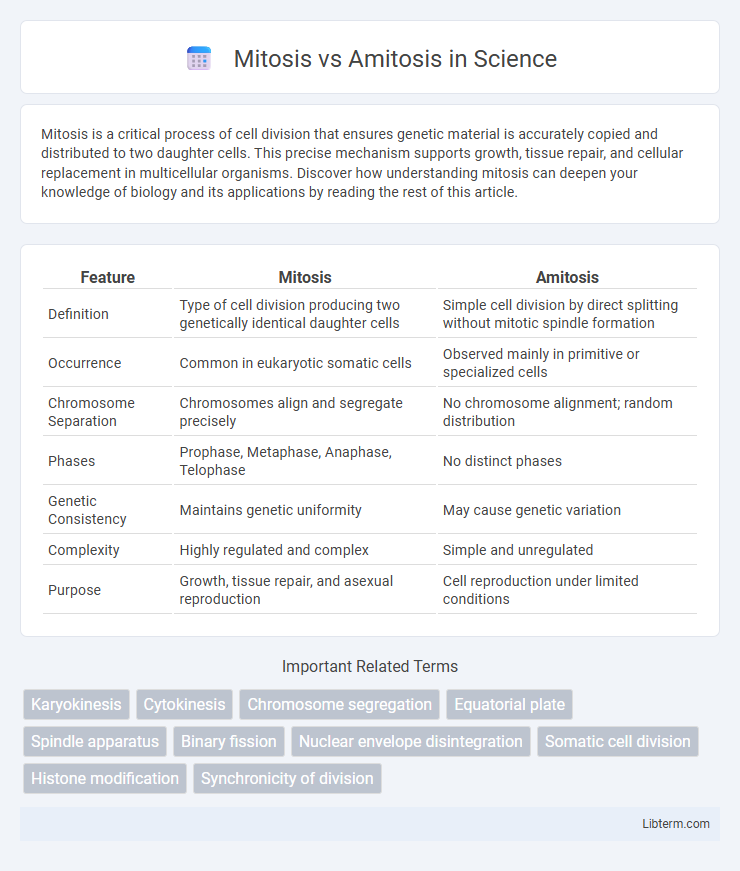Mitosis is a critical process of cell division that ensures genetic material is accurately copied and distributed to two daughter cells. This precise mechanism supports growth, tissue repair, and cellular replacement in multicellular organisms. Discover how understanding mitosis can deepen your knowledge of biology and its applications by reading the rest of this article.
Table of Comparison
| Feature | Mitosis | Amitosis |
|---|---|---|
| Definition | Type of cell division producing two genetically identical daughter cells | Simple cell division by direct splitting without mitotic spindle formation |
| Occurrence | Common in eukaryotic somatic cells | Observed mainly in primitive or specialized cells |
| Chromosome Separation | Chromosomes align and segregate precisely | No chromosome alignment; random distribution |
| Phases | Prophase, Metaphase, Anaphase, Telophase | No distinct phases |
| Genetic Consistency | Maintains genetic uniformity | May cause genetic variation |
| Complexity | Highly regulated and complex | Simple and unregulated |
| Purpose | Growth, tissue repair, and asexual reproduction | Cell reproduction under limited conditions |
Introduction to Cell Division
Cell division is a fundamental biological process by which a parent cell divides into two or more daughter cells, essential for growth, development, and tissue repair. Mitosis is a highly regulated process involving stages such as prophase, metaphase, anaphase, and telophase, ensuring accurate chromosome segregation. Amitosis, in contrast, is a simpler, direct division method without the formation of spindle fibers or chromosomal alignment, often observed in some unicellular organisms and specialized cells.
Overview of Mitosis
Mitosis is a highly regulated process of cell division that ensures equal distribution of replicated chromosomes into two genetically identical daughter cells. This phase of the cell cycle consists of distinct stages: prophase, metaphase, anaphase, and telophase, followed by cytokinesis, which completes cell division. Mitosis is essential for growth, tissue repair, and maintaining genetic stability in eukaryotic organisms.
Overview of Amitosis
Amitosis is a simple form of cell division characterized by the direct splitting of the cell nucleus and cytoplasm without the formation of chromosomes or spindle fibers, distinguishing it from mitosis. This process occurs in certain unicellular organisms, some protozoans, and occasionally in specific tissues of multicellular organisms, facilitating rapid cell proliferation. Amitosis lacks the complex regulatory mechanisms of mitosis, resulting in unequal distribution of genetic material and often leading to genetic variation in daughter cells.
Key Differences Between Mitosis and Amitosis
Mitosis involves a complex, multi-phase process that ensures equal distribution of duplicated chromosomes into two genetically identical daughter cells, while amitosis is a simpler, direct cell division without chromosome segregation. Mitosis maintains genetic stability through spindle fiber formation and chromosomal alignment, whereas amitosis results in uneven chromosomal distribution, often occurring in simpler organisms or specific tissues. The key difference lies in mitosis's role in growth and tissue repair with precise nuclear division compared to amitosis's less controlled, rapid division method.
Cellular Processes: Mitosis vs. Amitosis
Mitosis involves a complex sequence of stages--prophase, metaphase, anaphase, and telophase--ensuring precise chromosome alignment, segregation, and formation of two genetically identical daughter cells. Amitosis is a simpler, direct division where the nucleus and cytoplasm cleave without spindle formation or chromosomal organization, often resulting in uneven genetic material distribution. Cellular processes in mitosis support growth, tissue repair, and reproduction, while amitosis primarily occurs in some unicellular organisms and certain specialized tissues for rapid cell division.
Structural Changes During Division
During mitosis, the cell undergoes distinct structural changes including chromatin condensation into visible chromosomes, spindle fiber formation, and nuclear envelope breakdown, facilitating precise chromosome segregation. In amitosis, the nucleus divides directly without chromosome condensation or spindle apparatus formation, resulting in a simpler and less regulated partitioning of genetic material. These contrasting structural changes reflect the high fidelity of mitosis compared to the more primitive and quicker nature of amitosis.
Biological Significance and Functions
Mitosis ensures genetic stability by producing two genetically identical daughter cells, critical for growth, tissue repair, and asexual reproduction in eukaryotic organisms. Amitosis, a simpler and less precise form of cell division, primarily functions in unicellular organisms and certain protozoa, allowing rapid cell proliferation without the elaborate stages of mitosis. The biological significance of mitosis lies in its role in maintaining chromosomal integrity, while amitosis supports quick cellular multiplication where genetic variability is less crucial.
Occurrence in Different Organisms
Mitosis predominantly occurs in eukaryotic organisms, facilitating growth, tissue repair, and asexual reproduction by producing genetically identical daughter cells. Amitosis is primarily observed in certain unicellular eukaryotes, such as protozoans and some multinucleate cells, where the nucleus divides directly without chromosomal condensation or spindle formation. While mitosis ensures precise chromosomal segregation, amitosis allows rapid cell proliferation in specific contexts but results in genetic variability.
Advantages and Disadvantages of Each Process
Mitosis ensures genetic stability by producing two identical daughter cells, promoting tissue growth and repair with high fidelity, but it requires complex mechanisms and more time to complete. Amitosis occurs rapidly and with less energy expenditure, facilitating quick cell division in simple organisms, yet it risks unequal chromosome distribution leading to genetic abnormalities. The precise regulation in mitosis favors multicellular organism development, while amitosis serves as a simpler, less controlled replication method predominantly seen in unicellular or primitive cells.
Summary and Future Perspectives
Mitosis is a well-characterized process of nuclear division resulting in two genetically identical daughter cells, essential for growth and tissue repair in multicellular organisms. Amitosis, a simpler and less understood form of cell division, involves the direct splitting of the nucleus without chromosome alignment or spindle formation, often observed in unicellular organisms and certain specialized cells. Future research aims to elucidate the molecular mechanisms governing amitosis and its potential applications in regenerative medicine and cancer therapy, leveraging advances in live-cell imaging and genomic technologies.
Mitosis Infographic

 libterm.com
libterm.com